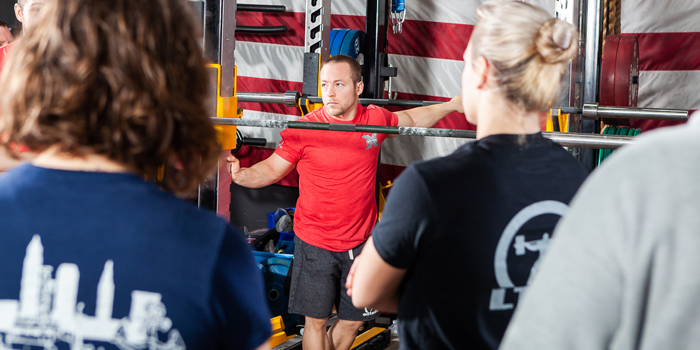
The elitefts Learn To Train X (LTTX) seminar took place in early August, bringing together trainers, coaches, athletes, and competitors across the powerlifting industry for the intensive three-day event. Participants were able to attend lectures from respected strength and performance educators, and also had the opportunity to experience hands-on instruction at training stations dedicated to perfecting squat, bench press, and deadlift techniques.
At the squat station, elitefts athlete Brandon Smitley coached participants in properly controlling the squat bar. He has a degree in Health and Fitness from Purdue University, a Masters in Coaching from Indiana State, and started Smitley Performance Systems as a means to help athletes reach their full, strength potential. Smitley also broke an all-time world record in 2015, squatting 567 pounds at a 132-pound body weight – as such, it’s safe to say that he knows a thing or two when it comes to this particular lift.
Stay Tight and Controlled
As participants gather round, Smitley first discusses speed during the squat. He explains that ultimately, speed is a personal preference, and may be a little different for everyone. When it comes to his own squatting technique, Smitley notes that he descends a lot slower when he has heavy weight on his back. Speed is not his problem – rather, grinding through the lift is.
Nonetheless, the important thing to note is that the way a lifter goes down into their squat will match the way that they come back up out of the movement; this includes the speed component. With that, uncontrolled speed can lead to the bar moving around on the platform, which not only impacts performance, but also can lead to potential injury.
I’d much rather you go down just a little bit more in control, staying good and tight, and you’ve got the speed to just come back up and it’s perfect… If you try to rebound it and the bar drills you down, well then, you’re screwed.
Because the bar follows the lifter, timing is key. Too fast, and they can’t time it properly in order to catch the rebound and drive the bar back up effectively. Smitley encourages the group to remain tight, steady, and controlled throughout the movement.
Let the Weight Settle
Control should start the moment that the lifter takes the bar. Even during the walk-out, Smitley demonstrates how lifters should allow a moment to let the weight “settle” before beginning the movement. This micro-pause can make a world of a difference when it comes to stability and control, thereby preventing the bar from moving around during the lift itself. This is particularly important during the walk-out, which requires the lifter to move the weight backwards – a maneuver that tends to feel uncomfortable and unnatural even for seasoned lifters.
Let the bar become completely motionless before you go, because if that bar is moving…[especially] if it’s your max attempt, that’s a lot of weight on your back and it’s going to throw you around, whether you like it or not.
In fact, this concept of letting the weight settle was one of the key technique adjustments that Smitley himself made when training his squat with Dave Tate. His work paid off, too, because it allowed him to better handle the platform at the Arnold competition, which had some give to it, which was causing the bar to move around more than normal. Staying tight and letting the weight settle enables a lifter to isolate the motion in the lift to just “up-down” – the only kind of motion that there should be in a squat done right.









